Weather challenges the past few winters has frustrated gardeners when it comes to their mophead hydrangeas not blooming. Seven criteria are necessary for healthy plants, with #4 and #7 being the most common reasons for failure.
In order for any plant to bloom, it has to be healthy. That means the plant is getting enough sunlight, food, and water so that when it comes time to make flower buds, everything is in place and ready to go. Unfortunately, incorrect pruning and lack of winter protection can quickly destroy all that you and the plant have worked so hard to do.
Everblooming mophead hydrangeas have a unique feature not present with other plants, and that is the ability to bloom on old wood as well as new wood. That means flower buds are formed in August to open in May or June the next year, and they form flower buds in April or May to open in July, August, or September. That’s a lot going on within the plant and that takes a lot of food. Keep in mind, any type of stress may interfere with this process.
The 7 steps to success with Mophead Hydrangeas:
1- Correct Location – Mophead hydrangeas wilt easily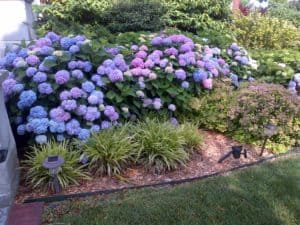 with summer’s heat. That wilting causes the homeowner to water whether the plant needs it or not. This type of hydrangea should be located on the north or east side of a structure to provide protection from hot sun. See #6 about correct watering. Also, mopheads don’t require a lot of light to bloom, but if conditions are too dark, they won’t set buds.
with summer’s heat. That wilting causes the homeowner to water whether the plant needs it or not. This type of hydrangea should be located on the north or east side of a structure to provide protection from hot sun. See #6 about correct watering. Also, mopheads don’t require a lot of light to bloom, but if conditions are too dark, they won’t set buds.
2- Soil Amendments at Time of Planting – If you’re going to take the time to plant something, do it right. That means amending our clay soils with compost. Since hydrangeas have enough challenges anyway, let’s not make poor planting practices the reason why mopheads won’t bloom. It’s all part of helping the plant be healthy.
3- Minimal Pruning – In March and April, the dormant stems look ugly, 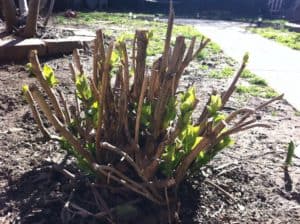 especially if new growth is coming out near the base of the plant. Any stem that shows no signs of life by mid to late spring can be removed. Cutting any stem that is alive may be removing flower buds, so it is best to prune as little as possible, or not at all.
especially if new growth is coming out near the base of the plant. Any stem that shows no signs of life by mid to late spring can be removed. Cutting any stem that is alive may be removing flower buds, so it is best to prune as little as possible, or not at all.
4- Feed Often – We are asking a lot of these powerhouses. Blooms from May until September takes a lot of energy. Your hydrangeas need to be fed often. We recommend Fertilome Premium Bedding Plant Food to be applied lightly every month from March until August. That is six times in spring and summer with a high phosphorus fertilizer.
5- Mulch in Summer – This step helps to reduce stress. Mulch keeps the soil cooler and helps to retain moisture. Also, as mulch (and compost) decomposes, it helps feed soil microbes which are necessary for the release of nutrients to the hydrangea roots.
6- Thorough Watering (but only 1-2 times per week) – It is critical 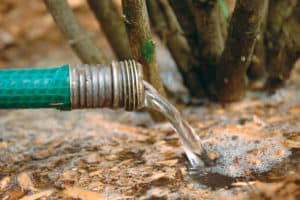 that all plants, especially mophead hydrangeas, be watered thoroughly but not very often. If a 3 gallon shrub is planted, it should have 3 to 6 gallons of water every time it is watered. Then, it must have time to dry out between waterings, so only once a week is necessary (2 times per week only during very hot, dry times). Remember, the shrub can wilt on hot days but it’s not because the plant is dry.
that all plants, especially mophead hydrangeas, be watered thoroughly but not very often. If a 3 gallon shrub is planted, it should have 3 to 6 gallons of water every time it is watered. Then, it must have time to dry out between waterings, so only once a week is necessary (2 times per week only during very hot, dry times). Remember, the shrub can wilt on hot days but it’s not because the plant is dry.
7- Mulch in Winter – Flower buds can freeze out if exposed to prolonged periods of cold temperatures. The best way to insulate these newly formed buds is to stuff leaves into the stems of the shrub, plus mounding more leaves or bark mulch around the base to create a mound 12-18″ high enclosing most of the shrub. Just a fresh 2″ layer of mulch is not enough to protect the flower buds from damaging cold weather. Burlap, cloth, or straw can also be used, but most people have access to lots of leaves. This covering should be put in place around Thanksgiving and needs to be removed by mid-March (St Patrick’s Day).
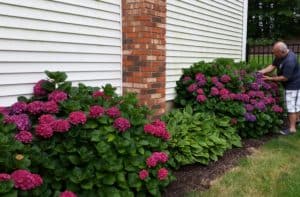
How to get “blue” hydrangeas – The blue color on changeable types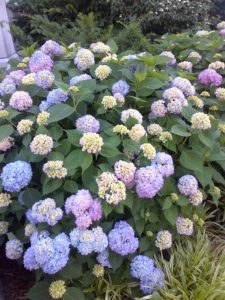 (not all pink hydrangeas can turn blue) occurs only with acidic soils. Apply sulfur to acidify our limey soils. Aluminum has been proven to intensify the blue coloring, so we recommend Aluminum sulfate. Sometimes a shrub will have blue, mauve, and pink all at the same time, such as in this photo. This is due to uneven application of the aluminum sulfate, the plants inability to take up this acidifier, or the plant is in the process of changing. Regardless, the plant is blooming…successfully!
(not all pink hydrangeas can turn blue) occurs only with acidic soils. Apply sulfur to acidify our limey soils. Aluminum has been proven to intensify the blue coloring, so we recommend Aluminum sulfate. Sometimes a shrub will have blue, mauve, and pink all at the same time, such as in this photo. This is due to uneven application of the aluminum sulfate, the plants inability to take up this acidifier, or the plant is in the process of changing. Regardless, the plant is blooming…successfully!
